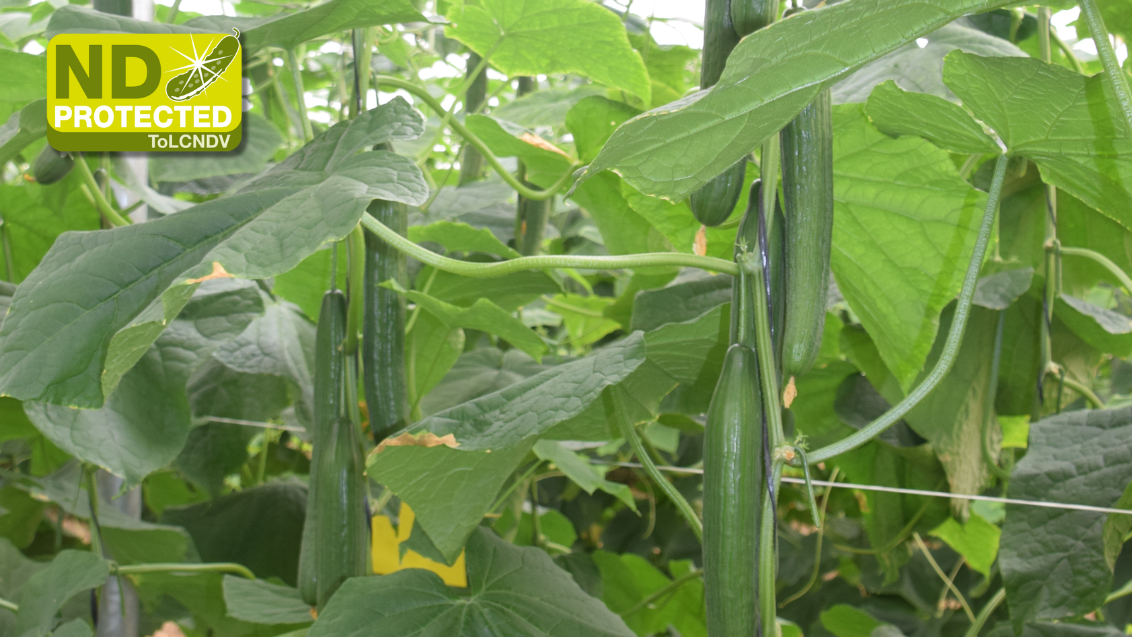September 7, 2023
 Siriana cucumbers feature resistance to yield-robbing viruses, including ToLCNDV
Siriana cucumbers feature resistance to yield-robbing viruses, including ToLCNDV
It might not be in the name Tomato Leaf Curl New Delhi Virus (ToLCNDV or New Delhi Virus), but cucumber production is at risk of decreased yields from this emerging threat.
“Growers who have ToLCNDV will see yellowing in leaves around the nerves, with wrinkling that curling toward the back sides of leaves,” said Pedro Pleguezuelo, Syngenta Vegetable Seeds Regional Portfolio Manager – Melon and Cucumber. “While the fruit itself might not show as many symptoms as some other cucurbits, yield potential is lost due to decreased photosynthetic activity.”
Our researchers moved quickly to create New Delhi Virus resistance in cucumber, without sacrificing resistances to other critical diseases. Syngenta Vegetable Seeds works alongside growers to understand the pests and diseases that impact crop yields most and uses a global breeding network and decades of experience to bring solutions.
ToLCNDV Protection Without Losing Other Disease Resistances
While New Delhi Virus was first discovered in Asia, it has spread to countries in and around the Mediterranean basin in cucurbit production areas. It has caused severe crop damages in Spain, Italy, and Tunisia. Because of this, growers are seeking solutions to protect yield and themselves from the spreading disease.
“We commercialized Siriana cucumbers this year with ToLCNDV resistance – a long cucumber most often grown in passive greenhouse,” Pleguezuelo said. “This variety is well adapted for our fall and spring plantings and because the resistance is built into the genetics, provides season-long protection.”
Siriana features New Delhi Virus resistance, without compromising resistances to other important diseases in cucumber. Syngenta researchers prioritize keeping resistances to the diseases that impact growers in any new product introduction. Because of this, Siriana has the ability to offer the widest package of resistances to:
- Px - Powdery Mildew
- Ccu – Cladosporium cucumerinum
- Cca – Corynespora cassiicola
- CGMMV – Cucumber Green Mottle Mosaic Virus
- CVYV – Cucumber Vein Yellowing Virus
- CYSDV – Cucumber Yellow Stunting Disorder Virus
- ToLCNDV – Tomato Leaf Curl New Delhi Virus
As research continues, protecting growers from the most important diseases in cucumber will remain top-of-mind in development. After all, ToLCNDV resistance is important but it’s not the only disease active today that can hurt yield, so well-rounded protection is critical.
Integrated management
ToLCNDV is transmitted by white fly Bemisia tabaci and is a Begomovirus. Because it’s transmitted by an insect, and can live i many different hosts, multiple control methods are possible and recommended to reduce the spread and protect current control methods.
“Controlling the virus vector (the white fly) is the first step we can take to control or delay getting or spreading the infections and early development of the virus,” Pleguezuelo said. Consider multiple methods for control, including crop protection products, biologicals and physical barriers like nets in greenhouses or small tunnels in open field crops.
The control gained with resistant varieties provides the highest level of efficacy, however. Because of this, Syngenta’s research into new solutions is ongoing in cucumber, and other cucurbit species impacted by New Delhi Virus.